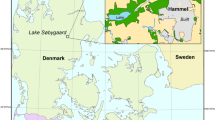Abstract.
A detailed budget of the fluxes of bio-available phosphorus (bio-P) was established for the ultra-oligotrophic Lake Brienz (Switzerland) and its catchment. Lake Brienz is a cold, deep oligotrophic peri-alpine lake that receives an annual load of approximately 300 kt of suspended sediments, mainly from two glacier-influenced rivers. The challenge was to overcome the associated high background of mineral-bound inorganic phosphorus (IP) of ~200 t yr−1 that is mostly inaccessible to algae growth. The application of six complementary, independent datasets allowed a consistent balance of bio-P to be obtained. We made use of data on (a) the load imported by the contributing rivers, (b) net sedimentation from cores, (c) export of bio-P from catchment land to the surface waters estimated by a GIS model, (d) the downward flux of bio-P through the water column from sediment traps, (e) primary production, and (f) the mineralization rate of organic material from the consumption of oxidants in the uppermost sediment of the lake. The average bio-P load estimated from import measurements and net sedimentation is 7.0 t yr−1 with an error of about 10%: An estimated 5.4 t yr−1 enters by way of the two main rivers (including 0.9 t yr−1 from sewage treatment plants), 1.2 t yr−1 from the remaining catchment (including 0.4 t yr−1 from sewage treatment plants that are diverted directly into the lake), and ~1 t yr−1 from atmospheric deposition. Approximately 2 t of bio-P are retained annually in the sediments of the upstream dams and thereby withheld from downstream Lake Brienz. The maximum eutrophication of the lake in the late 1970s and the subsequent re-oligotrophication can be attributed to the loads of urban wastewater. The drop in biological productivity since the late 1970s is consistent with the decrease of bio-P fluxes archived in the sediment, the record of the sewage treatment plant outflows and the few occasional in-situ observations.
Similar content being viewed by others
Author information
Authors and Affiliations
Corresponding author
Additional information
Received: 28 March 2006; revised manuscript accepted: 30 January 2007
Rights and permissions
About this article
Cite this article
Müller, B., Finger, D., Sturm, M. et al. Present and past bio-available phosphorus budget in the ultra-oligotrophic Lake Brienz. Aquat. Sci. 69, 227–239 (2007). https://doi.org/10.1007/s00027-007-0871-8
Published:
Issue Date:
DOI: https://doi.org/10.1007/s00027-007-0871-8




